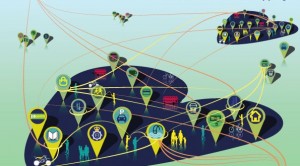Will Big Data Fix Big Cities?
-
-
slice.mit.edu
Filed Under
Recommended

Niki Gomez MBA ’09 hopes to fix that in London, where she currently lives. After co-authoring a study on how technology can improve downtown marketplaces, Gomez traveled to Parliament last week to present a report entitled “Future of Retail White Paper” along with entrepreneur Bill Grimsey.
Her report is a blueprint for towns seeking to reinvent the way they do business on their High Streets, leveraging the latest technology in big data and social networking.
London is known for its congestion zone system, which tracks and exacts auto tolls when your car goes in and out of certain high-traffic zones. Retailers could employ this technology, Gomez suggests, to figure out who is in the neighborhood. They could email or text deals, change offers in their signage real-time, and adjust parking rates to meet demand. Customers could earn neighborhood points by volunteering for nonprofits in the area or by making traditional retail purchases.
For businesses, Gomez envisions real-time mobile alerts telling owners what kinds of customers are walking into their stores, and more rent flexibility on High Streets, allowing startups to bid for retail spaces on an annual basis. Re-envisioning themselves as nodes in an interconnected user-experience, businesses could benefit by networking, both physically and virtually.
“We can’t go to the old models for help,” says Gomez, “Typical retail is only one way that people will buy now, rather than the only way. We have to find ways to make it more attractive.”
A committee of the House of Commons is reviewing the documents Gomez submitted. Her hope is to get government funding for pilot neighborhood experiments.
Rethinking High Street is only one project of Gomez’s, whose business savvy has led her to create several ventures.
Cybersalon is a website Gomez built in 1997 but relaunched in 2011 in conjunction with a monthly speakers’ series at a London storefront. Gomez brings together top thinkers to discuss all things cyber, from Bitcoin to cybersecurity and terrorism to 3D printing.
This spring, Gomez recounted her journey to find some of Bitcoin’s coders in London, who were squatting in an abandoned temple, in Wired UK.
The digital, non-governmental currency intrigues Gomez.
“I realized how political the whole thing was,” Gomez says. “Some alternative currencies come out of wanting real independence - from governments and from banks. The Bitcoin hackers I met are anarchists, but not all Bitcoiners are. A lot of people in suits are taking it seriously too! It's still to be seen whether this interest is as a commodity - buying into the innovation of the idea - or really as a currency, as you still can't buy that much with Bitcoins."
When not working on Cybersalon, Gomez does independent consulting work. Her clients have included a global fitness brand, IBM, Samsung and Godrej, one of India's largest conglomerates, for who she developed Gojiyo.com, a Second-Life like virtual game. She is also at work on a luxury-line of digitally printed saris.







